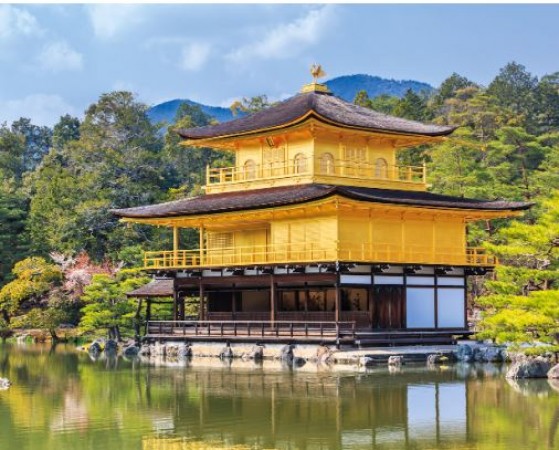
Kinkaku-Ji Temple is located within the enchanting city of Kyoto, Japan, stands the resplendent Kinkaku-ji Temple, also known as the Golden Pavilion. This iconic Zen Buddhist temple is a timeless masterpiece that captivates visitors with its awe-inspiring beauty, rich history, and spiritual significance. The temple's allure lies not only in its striking architecture but also in the surrounding gardens, which have been carefully designed to harmonize with the pavilion's golden splendor. As one of Japan's most famous landmarks, Kinkaku-ji Temple serves as a symbol of the country's cultural heritage and continues to be an essential pilgrimage site for both locals and international travelers seeking tranquility, introspection, and a glimpse into Japan's golden past.
Also Read: White Horse Temple: A Historical and Cultural Icon of China
Kinkaku-ji Temple's history dates back to the 14th century when it was originally built as a retirement villa for the shogun Ashikaga Yoshimitsu. The shogun, a patron of the arts and culture, sought to create an idyllic haven where he could meditate, write poetry, and appreciate the beauty of nature. After his death in 1408, the villa was transformed into a Zen Buddhist temple, adhering to the shogun's last wishes. The temple was named Rokuon-ji, but it later became popularly known as Kinkaku-ji due to the building's exterior covered in dazzling gold leaf.
The architecture of Kinkaku-ji Temple is a harmonious blend of three distinct styles, each representing a different period in Japanese history. The first floor, known as the Chamber of Dharma Waters, is built in the Shinden-zukuri style, characterized by its imperial palace design with wooden pillars and a veranda. The second floor, the Tower of Sound Waves, reflects the Bukke-zukuri style, a warrior residence design that features shoji sliding doors and tatami floors. Finally, the third and uppermost floor, called the Cupola of the Ultimate, follows the traditional Chinese Zen Hall style, adding a distinctive touch to the pavilion's structure.
Also Read: Famen Temple: A Journey through Time and Spirit
The crowning glory of the temple is its brilliant golden exterior, a stunning sight that reflects upon the shimmering surface of the pond below. The gold leaf, meticulously applied to the building's surfaces, glistens under the sunlight, creating an otherworldly spectacle that enchants all who behold it. This glimmering facade is a testament to the architectural brilliance of the craftsmen of that era and has become one of Japan's most iconic images, gracing postcards, calendars, and travel magazines worldwide.
The beauty of Kinkaku-ji Temple extends beyond the shimmering pavilion, as its immaculate gardens play an integral role in enhancing the overall charm of the temple complex. These meticulously designed gardens, known as the "Pure Land Gardens," were crafted to embody the Buddhist principles of harmony and balance. The gardens feature carefully placed stones, meandering paths, and lush greenery, creating a serene and contemplative atmosphere.
Also Read: Maya Devi Temple, Lumbini: Discovering the Sacred Birthplace of Lord Buddha
Near the main temple, visitors can find the Fudo Hall, dedicated to Fudo Myoo, one of the fiercer deities in the Buddhist pantheon. The hall houses a striking image of Fudo Myoo, a stunning and awe-inspiring representation that exudes both strength and compassion. This deity is believed to provide protection from calamities and grant wisdom to seekers of enlightenment.
Kinkaku-ji Temple holds immense cultural and spiritual significance for the people of Japan. It is a UNESCO World Heritage site and serves as a symbol of the country's rich history and heritage. The temple has withstood numerous challenges over the centuries, including fires and wars, yet it remains a timeless symbol of resilience and cultural pride.
Also Read: Pashupatinath Temple: Nepal's Spiritual and Cultural Gem
Beyond its architectural splendor, Kinkaku-ji Temple continues to be a prominent place of Buddhist practice and reflection. It serves as a place of pilgrimage for Buddhists and other visitors seeking spiritual solace and enlightenment. The temple's serene environment, coupled with the sound of monks chanting and the soothing ambiance of the gardens, fosters a unique sense of tranquility and mindfulness.
Visitors from around the world come to Kinkaku-ji Temple to witness its beauty, experience its spiritual ambiance, and immerse themselves in Japan's profound cultural heritage. The temple attracts tourists, artists, poets, and philosophers alike, who draw inspiration from its timeless elegance and the philosophy it represents.
The preservation of Kinkaku-ji Temple remains a top priority for the Japanese government and local authorities. Conservation efforts are carried out regularly to maintain the temple's grandeur and ensure that future generations can continue to appreciate its beauty and historical significance.
Also Read: Hollywood Sikh Temple: Promoting Interfaith Dialogue and Understanding
The temple's global fame has also significantly impacted tourism in Kyoto and Japan as a whole. Kinkaku-ji Temple draws millions of visitors annually, contributing to the region's economy while fostering an understanding and appreciation of Japanese culture and traditions.
Kinkaku-ji Temple, the Golden Pavilion, stands as an exquisite gem in Japan's rich cultural heritage. Its breathtaking beauty, combined with the meticulously landscaped gardens and spiritual ambiance, creates an unparalleled experience for all who visit. As a testament to Japan's glorious past and unwavering commitment to preserving its cultural legacy, Kinkaku-ji Temple stands tall as a living masterpiece, inviting travelers from far and wide to witness its golden splendor and be inspired by its enduring wisdom.
Also Read: Kom Ombo Temple: A Fascinating Ancient Marvel in Egypt
From Bangalore to Pondicherry, Here Are Seven Places to Visit in Tamil Nadu